Large Differences between Glaciers 3D Surface Extents and 2D Planar Areas in Central Tianshan
Abstract
:1. Introduction
2. Study Area and Data Analysis
2.1. Study Area
2.2. Data and Analysis
3. Results
3.1. Glacier Outline Extractions
3.2. Glacier Distributions
3.3. Glacier Area Changes
4. Discussion
4.1. Glacier Classifications
4.2. Difference between Glacier 2D and 3D Areas
5. Summary and Remark
Acknowledgments
Author Contributions
Conflicts of Interest
References
- Aizen, V.B.; Aizen, E.M.; Kuzmichonok, V.A. Glaciers and hydrological changes in the Tien Shan: simulation and prediction. Environ. Res. Lett. 2007, 2, 45019. [Google Scholar] [CrossRef]
- Adhikari, S.; Marshall, S.J. Glacier volume-area relation for high-order mechanics and transient glacier states. Geophys. Res. Lett. 2012, 39, 6. [Google Scholar] [CrossRef]
- Bahr, D.B.; Meier, M.F.; Peckham, S.D. The physical basis of glacier volume-area scaling. J. Geophys. Res. Solid Earth 1997, 102, 20355–20362. [Google Scholar] [CrossRef]
- Chen, J.; Ohmura, A. Estimation of alpine glacier water resources and their change since the 1870s. In Hydrology in Mountainous Regions. I: Hydrological Measurements, the Water Cycle, Proceedings of Two International Symposia, Lausanne, Switzerland, 27 August–1 September 1990; Lang, H., Musy, A., Eds.; International Association of Hydrological Sciences (IAHS): Wallingford, UK, 1990; Volume 193, pp. 127–135. [Google Scholar]
- Farinotti, D.; Huss, M.; Bauder, A.; Funk, M.; Truffer, M. A method to estimate the ice volume and ice-thickness distribution of alpine glaciers. J. Glaciol. 2009, 55, 422–430. [Google Scholar] [CrossRef]
- Meier, M.F.; Dyurgerov, M.B.; Rick, U.K.; O'Neel, S.; Pfeffer, W.T.; Anderson, R.S.; Anderson, S.P.; Glazovsky, A.F. Glaciers Dominate Eustatic Sea-Level Rise in the 21st Century. Science 2007, 317, 1064–1067. [Google Scholar] [CrossRef] [PubMed]
- Cogley, J.G.; Hock, R.; Rasmussen, L.A.; Arendt, A.A.; Bauder, A.; Braithwaite, R.J.; Jansson, P.; Kaser, G.; Möller, M.; Nicholson, L. Glossary of Glacier Mass Balance and Related Terms; IHP-VII Technical Documents in Hydrology No. 86, IACS Contribution No. 2; UNESCO-IHP: Paris, France, 2011. [Google Scholar]
- Fierz, C.; Armstrong, R.L.; Durand, Y.; Etchevers, P.; Greene, E.; McClung, D.M.; Nishimura, K.; Satyawali, P.K.; Sokratov, S.A. The International Classification for Seasonal Snow on the Ground; IHP-VII Technical Documents in Hydrology No.83, IACS Contribution No.1; UNESCO-IHP: Paris, France, 2009. [Google Scholar]
- Zhang, Y.; Luo, Y.; Sun, L.; Liu, S.; Chen, X.; Wang, X. Using glacier area ratio to quantify effects of melt water on runoff. J. Hydrol. 2016, 538, 269–277. [Google Scholar] [CrossRef]
- Guo, W.; Liu, S.; Xu, J.; Wu, L.; Shangguan, D.; Yao, X.; Wei, J.; Bao, W.; Yu, P.; Liu, Q. The second Chinese glacier inventory: Data, methods and results. J. Glaciol. 2015, 61, 357–372. [Google Scholar] [CrossRef]
- Zhao, J.; Song, Y.; King, J.W.; Liu, S.; Wang, J.; Wu, M. Glacial geomorphology and glacial history of the Muzart River valley, Tianshan Range, China. Quat. Sci. Rev. 2010, 29, 1453–1463. [Google Scholar] [CrossRef]
- Bajracharya, S.R.; Maharjan, S.B.; Shrestha, F. The status and decadal change of glaciers in Bhutan from the 1980s to 2010 based on satellite data. Ann. Glaciol. 2014, 55, 159–166. [Google Scholar] [CrossRef]
- Ke, L.; Ding, X.; Song, C. Heterogeneous changes of glaciers over the western Kunlun Mountains based on ICESat and Landsat-8 derived glacier inventory. Remote Sens. Environ. 2015, 168, 13–23. [Google Scholar] [CrossRef]
- Paul, F.; Bolch, T.; Kääb, A.; Nagler, T.; Nuth, C.; Scharrer, K.; Shepherd, A.; Strozzi, T.; Ticconi, F.; Bhambri, R. The glaciers climate change initiative: Methods for creating glacier area, elevation change and velocity products. Remote Sens. Environ. 2015, 162, 408–426. [Google Scholar] [CrossRef]
- Petrakov, D.; Shpuntova, A.; Aleinikov, A.; Kääb, A.; Kutuzov, S.; Lavrentiev, I.; Stoffel, M.; Tutubalina, O.; Usubaliev, R. Accelerated glacier shrinkage in the Ak-Shyirak massif, Inner Tien Shan, during 2003–2013. Sci. Total Environ. 2016, 562, 364–378. [Google Scholar] [CrossRef] [PubMed]
- Wang, P.; Li, Z.; Wang, W.; Li, H.; Wu, L.; Huai, B.; Zhou, P.; Jin, S.; Wang, L. Comparison of changes in glacier area and thickness on the northern and southern slopes of Mt. Bogda, eastern Tianshan Mountains. J. Appl. Geophys. 2016, 132, 164–173. [Google Scholar] [CrossRef]
- Zhang, Y.; Zhang, L.; Yang, C.; Bao, W.; Yuan, X. Surface area processing in GIS for different mountain regions. Forest Sci. Pract. 2011, 13, 311–314. [Google Scholar] [CrossRef]
- Pieczonka, T.; Bolch, T.; Wei, J.; Liu, S. Heterogeneous mass loss of glaciers in the Aksu-Tarim Catchment (Central Tien Shan) revealed by 1976 KH-9 Hexagon and 2009 SPOT-5 stereo imagery. Remote Sens. Environ. 2013, 130, 233–244. [Google Scholar] [CrossRef]
- World Data Center for Glaciology and Geocryology, Lanzhou. Available online: http://wdcdgg.westgis.ac.cn/ (accessed on 12 October 2015).
- Kraaijenbrink, P.D.A.; Shea, J.M.; Pellicciotti, F.; Jong, S.M.D.; Immerzeel, W.W. Object-based analysis of unmanned aerial vehicle imagery to map and characterise surface features on a debris-covered glacier. Remote Sens. Environ. 2016, 186, 581–595. [Google Scholar] [CrossRef]
- Nijhawan, R.; Garg, P.; Thakur, P. A comparison of classification techniques for glacier change detection using multispectral images. Perspect. Sci. 2016, 8, 377–380. [Google Scholar] [CrossRef]
- Robson, B.A.; Nuth, C.; Dahl, S.O.; Hölbling, D.; Strozzi, T.; Nielsen, P.R. Automated classification of debris-covered glaciers combining optical, SAR and topographic data in an object-based environment. Remote Sens. Environ. 2015, 170, 372–387. [Google Scholar] [CrossRef]
- Huang, C.; Davis, L.S.; Townshend, J.R.G. An assessment of support vector machines for land cover classification. Int. J. Remote Sens. 2002, 23, 725–749. [Google Scholar] [CrossRef]
- ASTER Global Digital Elevation Model (GDEM). Available online: http://gdem.ersdac.jspacesystems.or.jp/ (accessed on 12 March 2016).
- Frey, H.; Paul, F. On the suitability of the SRTM DEM and ASTER GDEM for the compilation of topographic parameters in glacier inventories. Int. J. Appl. Earth Obs. 2012, 18, 480–490. [Google Scholar] [CrossRef]
- Mashimbye, Z.E.; Clercq, W.P.D.; Niekerk, A.V. An evaluation of digital elevation models (DEMs) for delineating land components. Geoderma 2014, 213, 312–319. [Google Scholar] [CrossRef]
- Shangguan, D.H.; Bolch, T.; Ding, Y.J.; Kröhnert, M.; Pieczonka, T.; Wetzel, H.U.; Liu, S.Y. Mass changes of Southern and Northern Inylchek Glacier, Central Tian Shan, Kyrgyzstan, during ∼1975 and 2007 derived from remote sensing data. Cryosphere 2015, 9, 703–717. [Google Scholar] [CrossRef]
- Du, W.; Li, J. Mapping changes in the glaciers of the eastern Tienshan Mountains during 1977–2013 using multitemporal remote sensing. J. Appl. Remote Sens. 2014, 8, 689–697. [Google Scholar] [CrossRef]
- Kaldybayev, A.; Chen, Y.; Vilesov, E. Glacier change in the Karatal river basin, Zhetysu (Dzhungar) Alatau, Kazakhstan. Ann Glaciol 2016, 57, 11–19. [Google Scholar] [CrossRef]
- Wang, L.; Li, Z.; Wang, F.; Li, H.; Wang, P. Glacier changes from 1964 to 2004 in the Jinghe River basin, Tien Shan. Cold Reg. Sci. Technol. 2014, 102, 78–83. [Google Scholar] [CrossRef]
- Narama, C.; Kääb, A.; Duishonakunov, M.; Abdrakhmatov, K. Spatial variability of recent glacier area changes in the Tien Shan Mountains, Central Asia, using Corona (~1970), Landsat (~2000), and ALOS (~2007) satellite data. Glob. Planet. Chang. 2010, 71, 42–54. [Google Scholar] [CrossRef]
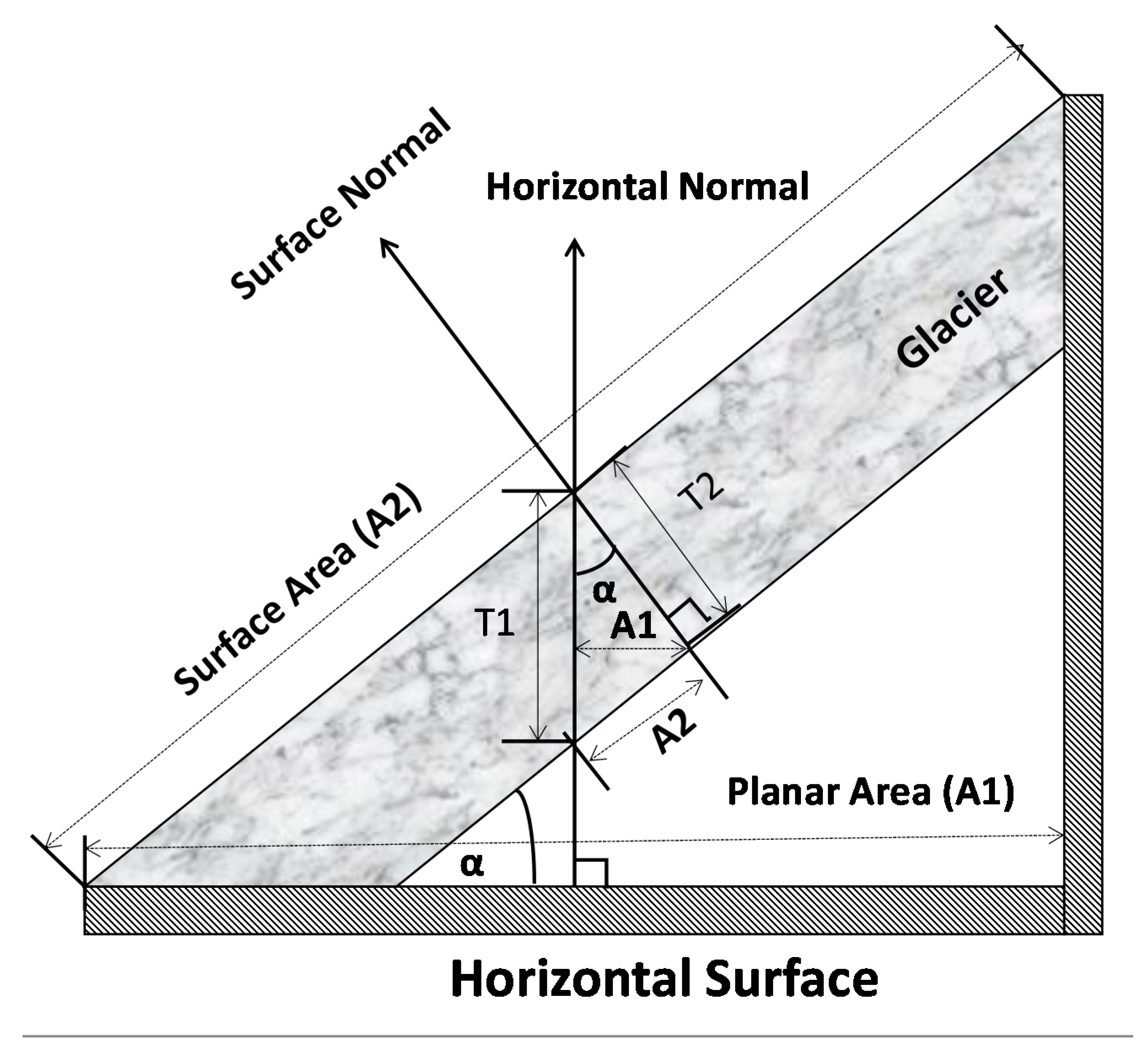
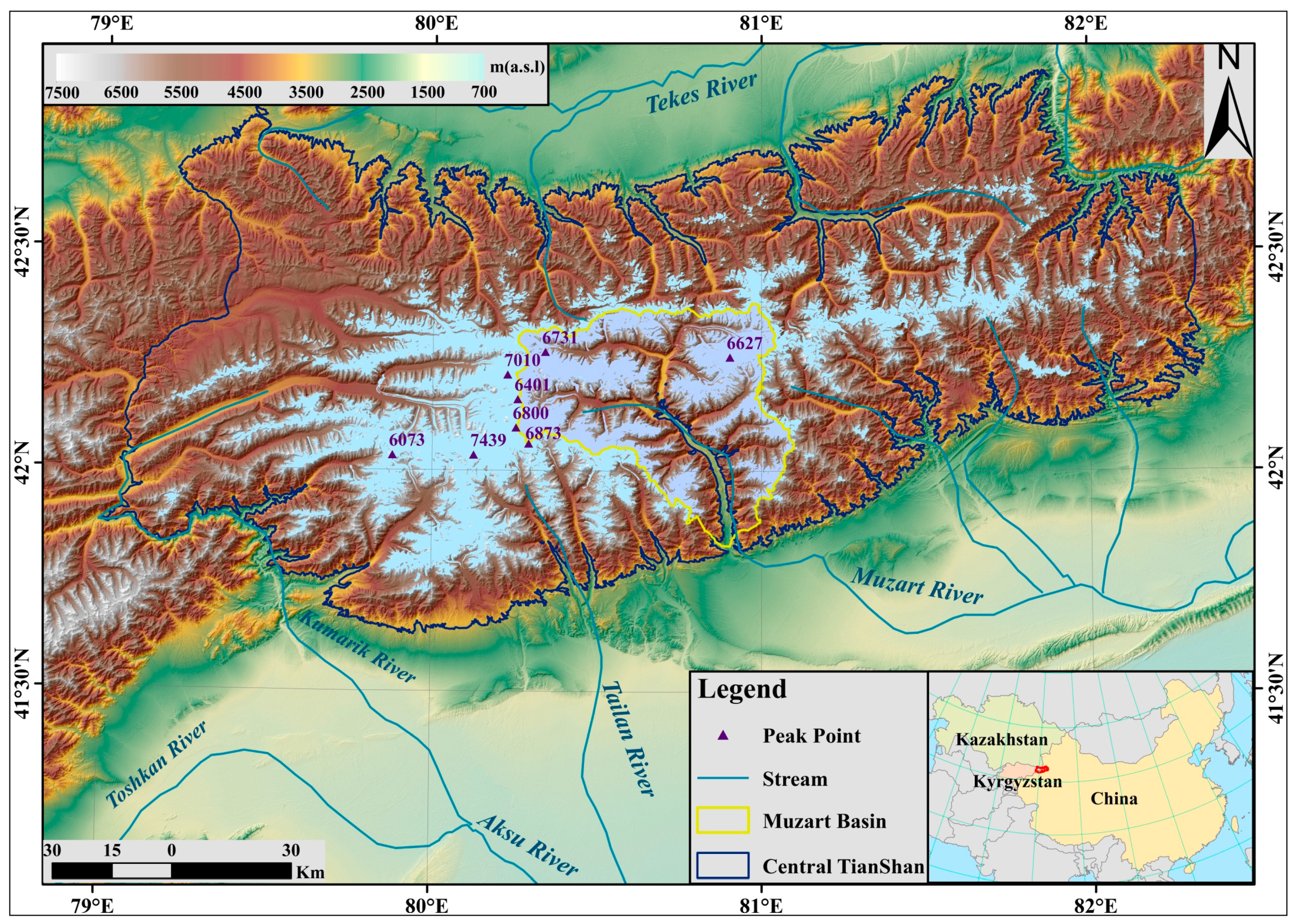
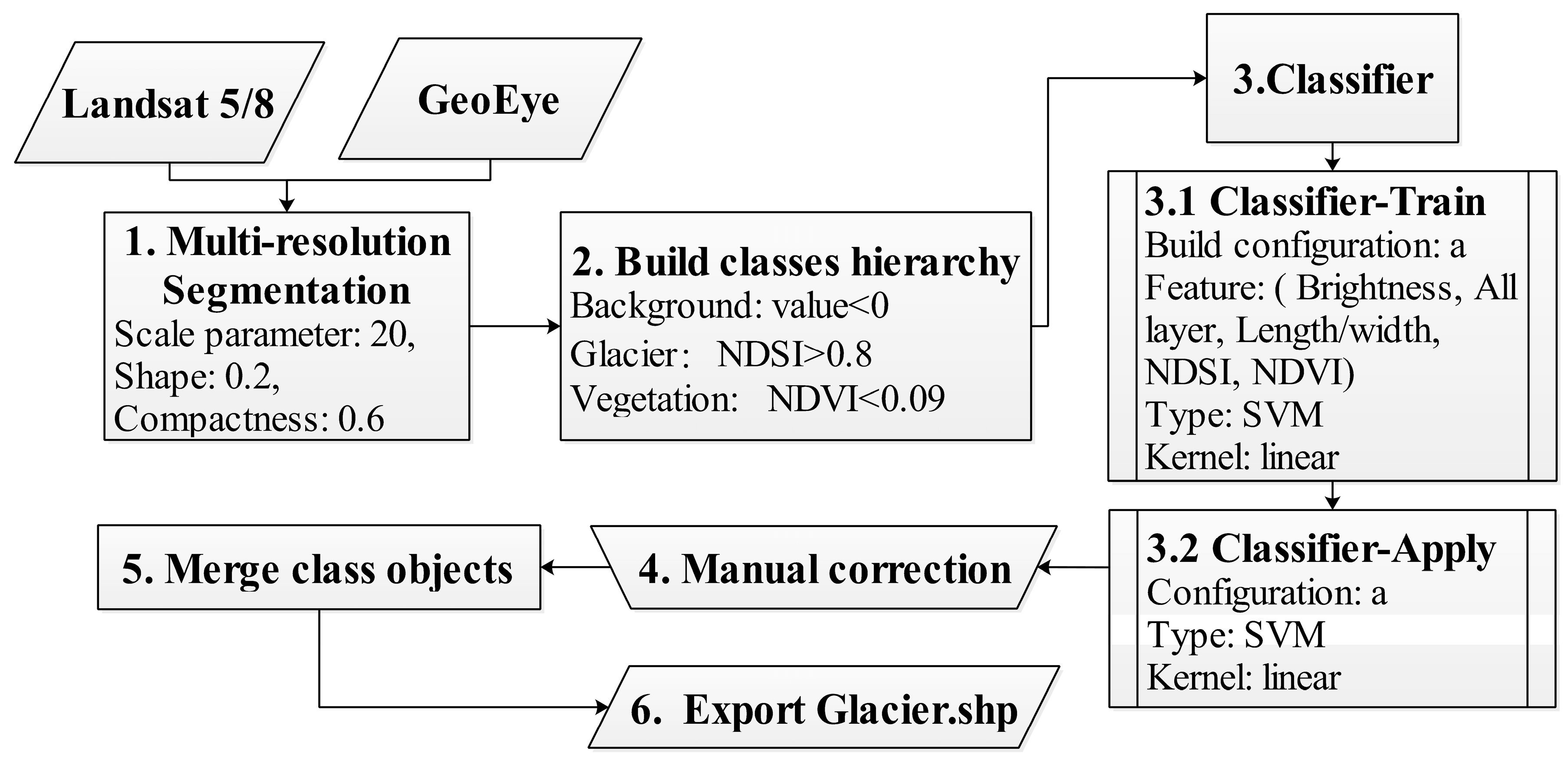
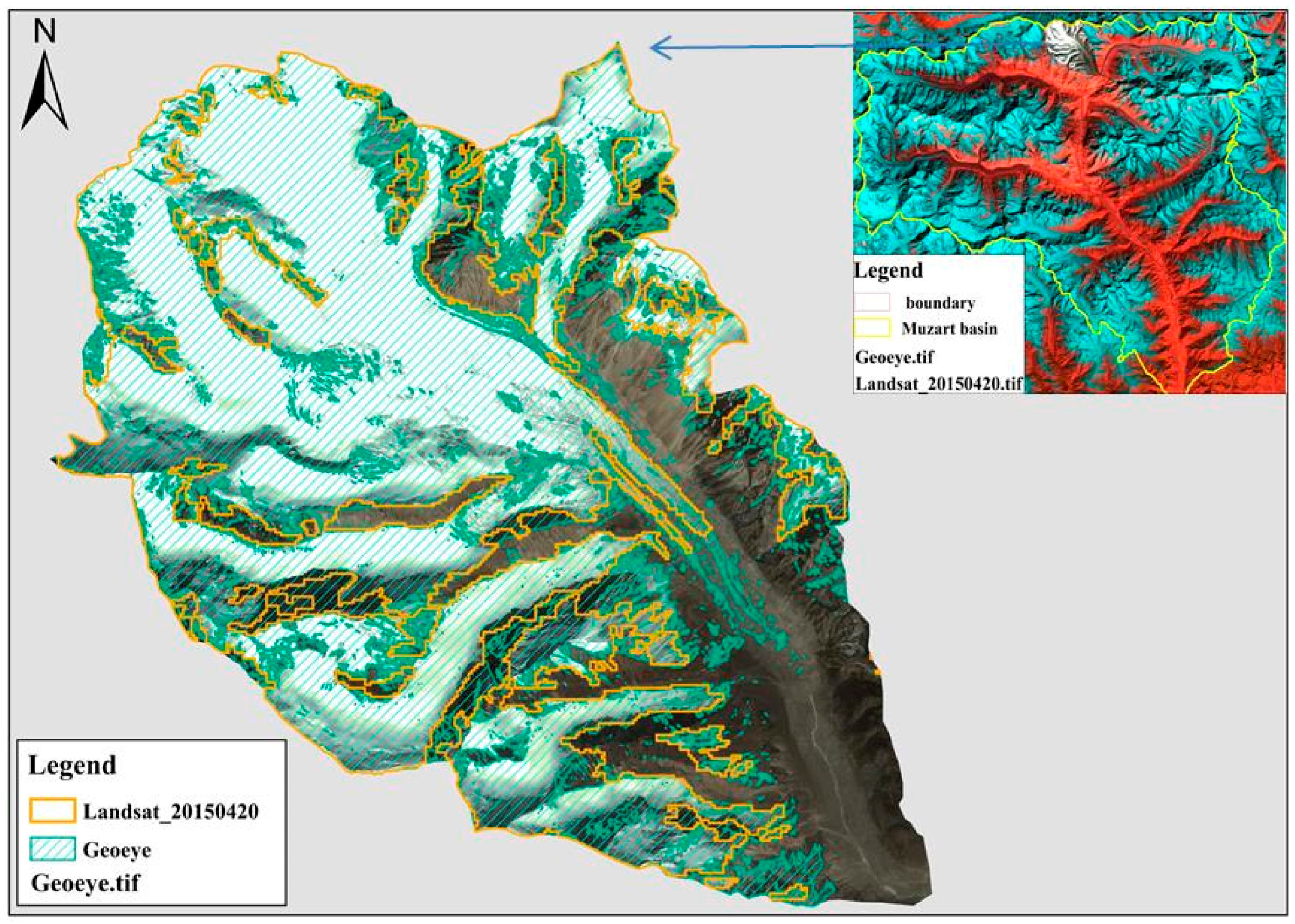
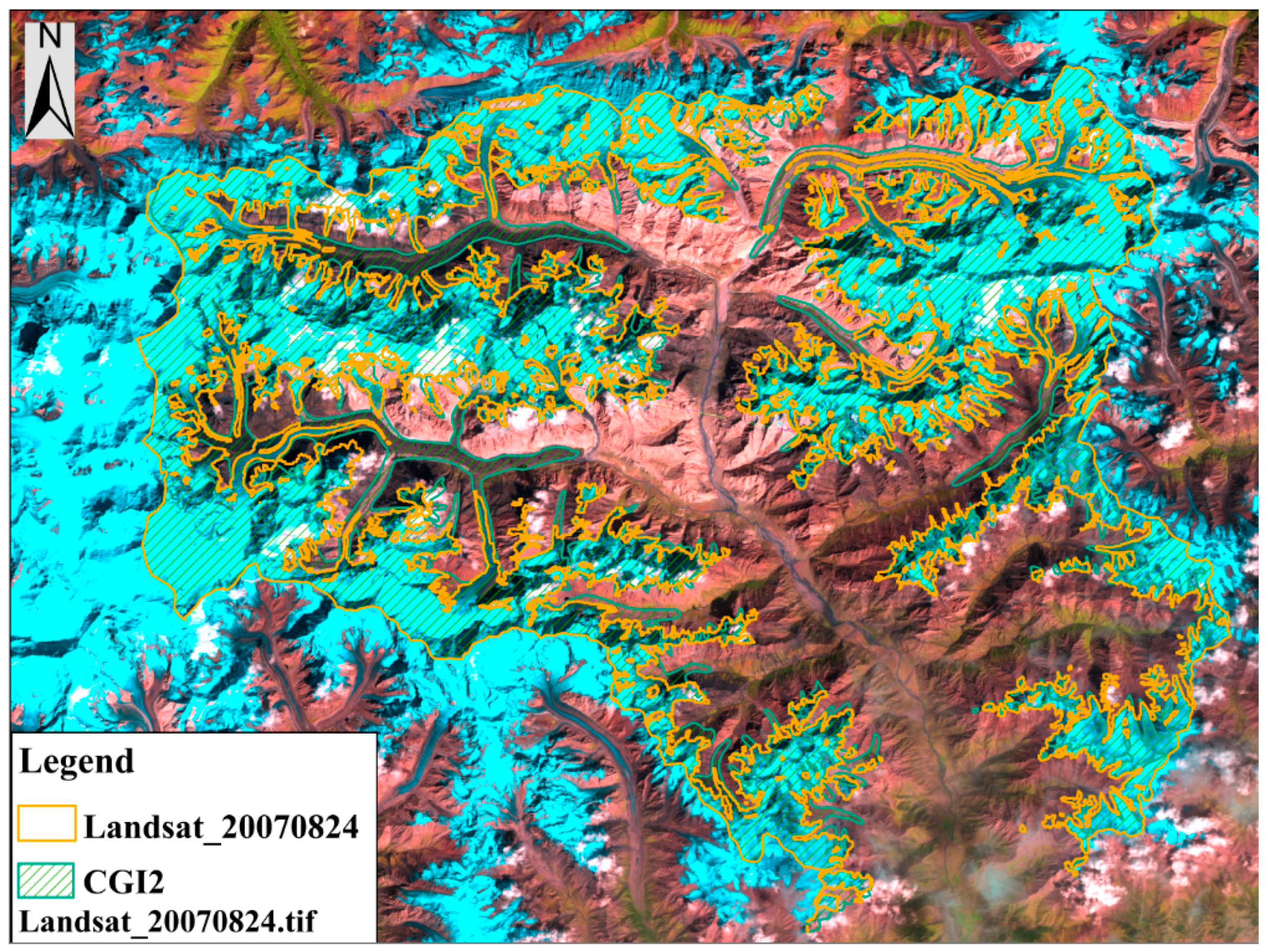

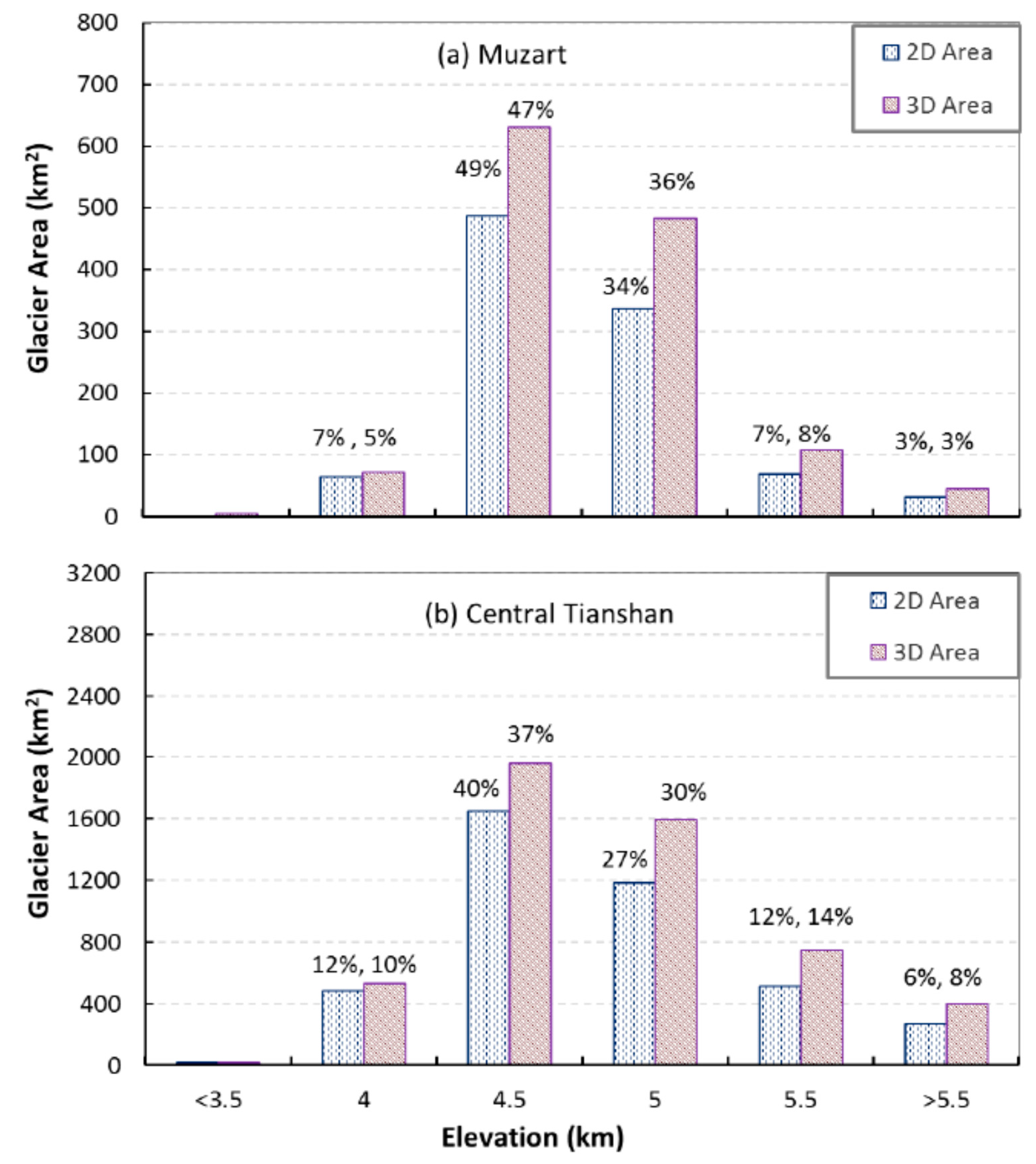
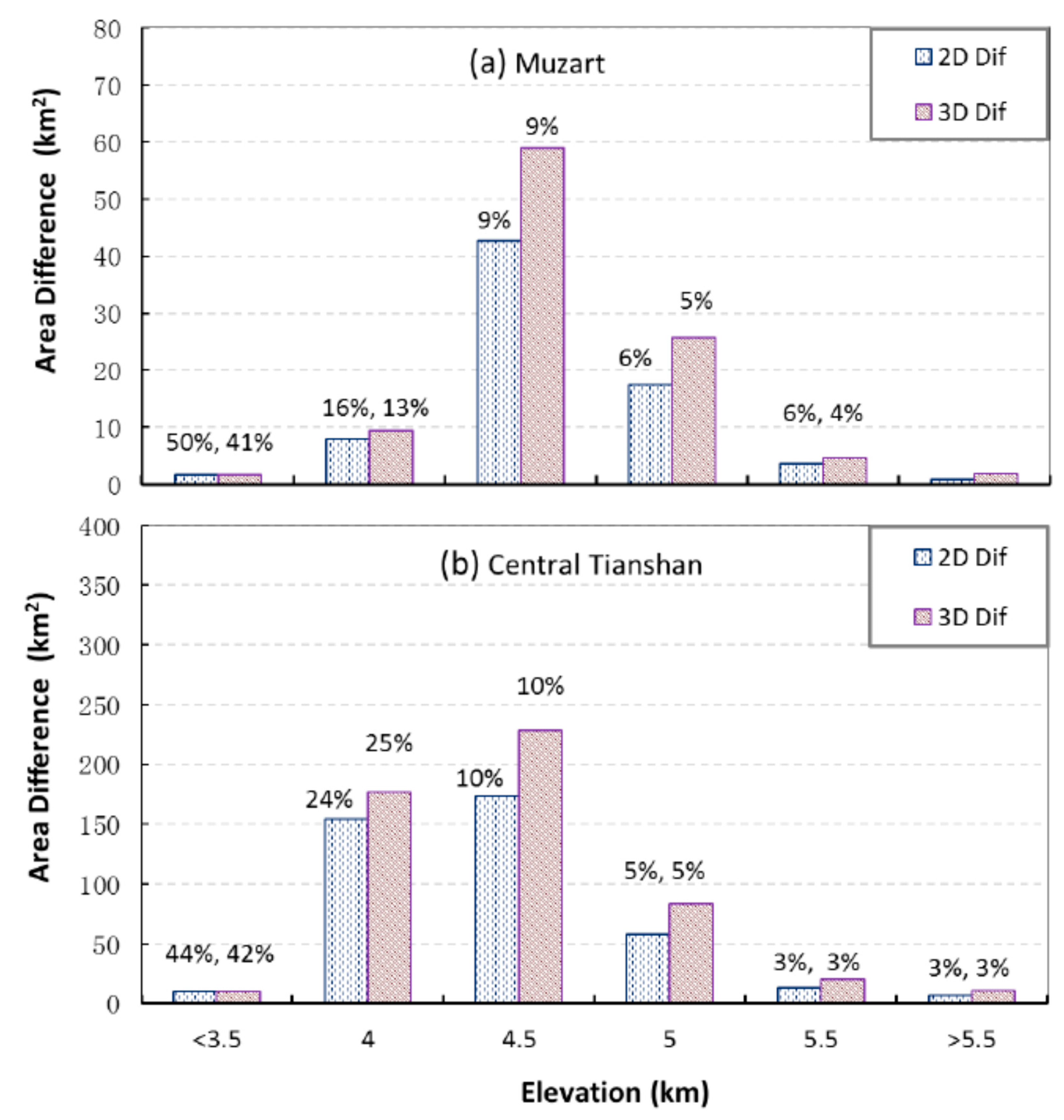

| Image Classification | Reference (km2) | 2015 Landsat 8 OLI (km2) | ||
|---|---|---|---|---|
| Glacier | Non-Glacier | |||
| GeoEye01 | Glacier | 32.8 | 29.3 | 3.5 |
| 89.3% | 10.7% | |||
| Non-glacier | 17.7 | 3.8 | 13.9 | |
| 21.5% | 78.5% | |||
| Overall Accuracy | 85.5% | |||
| Glaciers | Muzart Glacier Catchment | Central Tianshan Mountain | ||||
|---|---|---|---|---|---|---|
| 2D Area | 3D Area | Relative Difference (3D-2D)/2D | 2D Area | 3D Area | Relative Difference (3D-2D)/2D | |
| CGI2 | 1160 | 1557 | 34.2% | |||
| 24 August 2007 | 1036 | 1431 | 38.1% | 4518 | 5778 | 27.9% |
| Landsat/CGI2 | 89.3% | 91.9% | ||||
| 10 September 2013 | 953 | 1316 | 38.1% | 4101 | 5244 | 27.9% |
| Dif. (2013–2007) Dif. (2013–2007)/2007 | −81 | −111 | 37.0% | −418 | −533 | 27.6% |
| −7.76% | −7.82% | −9.25% | −9.23% | |||
| Location | Region | Period | 2D Area Changes (%) | Change Rate (%.a−1) | Document Source |
|---|---|---|---|---|---|
| Jinghe River Basin | Eastern Tianshan | 1964–2004 | −15.2 | −0.4 | [30] |
| Karatal River Basin | Northern Tianshan | 1989–2012 | −23.0 | −1.0 | [29] |
| Ak-Shyirak massif | Western Tianshan | 2003–2013 | −5.9 | −0.6 | [15] |
| Ili-Kungoy | Central Tianshan | 2007–2013 | −4.0 | −0.4 | [31] |
| Mt. Karlik | Eastern Tianshan | 2007–2013 | −9.9 | −1.7 | [28] |
| Inylchek Glacier | Central Tianshan | 1999–2007 | −0.3 | −0.1 | [27] |
| Muzart Glacier (south) | Central Tianshan | 2007–2013 | −7.8 | −1.1 | This study |
| Central Tianshan | Central Tianshan | 2007–2013 | −9.2 | −1.3 | This study |
© 2017 by the authors. Licensee MDPI, Basel, Switzerland. This article is an open access article distributed under the terms and conditions of the Creative Commons Attribution (CC BY) license (http://creativecommons.org/licenses/by/4.0/).
Share and Cite
Wang, X.; Chen, H.; Chen, Y. Large Differences between Glaciers 3D Surface Extents and 2D Planar Areas in Central Tianshan. Water 2017, 9, 282. https://doi.org/10.3390/w9040282
Wang X, Chen H, Chen Y. Large Differences between Glaciers 3D Surface Extents and 2D Planar Areas in Central Tianshan. Water. 2017; 9(4):282. https://doi.org/10.3390/w9040282
Chicago/Turabian StyleWang, Xianwei, Huijiao Chen, and Yaning Chen. 2017. "Large Differences between Glaciers 3D Surface Extents and 2D Planar Areas in Central Tianshan" Water 9, no. 4: 282. https://doi.org/10.3390/w9040282
APA StyleWang, X., Chen, H., & Chen, Y. (2017). Large Differences between Glaciers 3D Surface Extents and 2D Planar Areas in Central Tianshan. Water, 9(4), 282. https://doi.org/10.3390/w9040282








